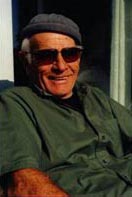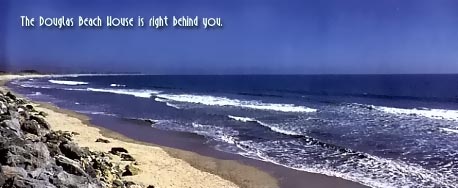Dynamite on the Beach
One on One Interview with Pete Douglas, Founder & Concert Manager
Diana Fox, interviewer, for ARIES COMMUNICATION GROUP LLC, August, 2002
 The wooden beach front home of the Bach Dancing and Dynamite Society sprawls, wind-smoothed and sun-bleached, on the edge of the ocean, almost as if it grew naturally out of the confluence of sand, sea and sound.
The wooden beach front home of the Bach Dancing and Dynamite Society sprawls, wind-smoothed and sun-bleached, on the edge of the ocean, almost as if it grew naturally out of the confluence of sand, sea and sound.
In fact, Bach Dancing & Dynamite was conjured into existence over several decades by a Homer of music, whose narrative is the ever-evolving story of instrumental and vocal sound. Pete Douglas, sun-toughened and craggy as the rocks that line this stretch of Pacific coast, has been a fixture here for ages, in human if not geological terms. With his round beanie (until recently it was a Greek sailor’s hat) and pipe, he has a mythic quality that fits well with his tireless telling of musical tales.
“I’ve been on a personal music adventure,” he says of his 37 years running this most unusual of music venues. “I not only did all forms of chamber music, but there’s not one aspect of the evolution of jazz that hasn’t been performed here.”
Whether it’s Bach or BeBop, Pete Douglas’s mission has been to inveigle people to listen - not so much to his stories as to the musicians he gathers from all over the county and the world, to perform on his small stage in the wide upper room he started building in 1966. Here, music-makers and music-lovers get close up and personal during long, leisurely afternoons of sound - jazz, classical, world traditional, cutting-edge, or impossible to categorize.
Over the years, these walls have heard an astonishing range of sounds, from locally- based jazzmen Vince Guaraldi and Cal Tjader to Stan Getz and members of the Guarneri and Julliard Quartets. The upcoming season includes Blues from Dr. Lonnie Smith on the Hammond organ with his Trio, a seven piece Cuban group led by jazz sax and flute player, Jane Bunnett, Flamenco Guitarist, Mariano Cordoba, and a group of international classical
“My booking philosophy is not what kind of music it is, but if it’s the best, if they play with authenticity and humanity that really comes across. I like having an eclectic approach, because then it’s a learning experience.”
Though jazz has always dominated the programming, the Bach Society also attracts a wide range of first-class players in different fields, despite lower than usual fees.
“There’s a real magic that the musicians cannot help but be caught up in, partly because of the natural surroundings, partly because of the friendly atmosphere,” wrote Richard Young, a chamber violinist, after his first visit. Another said, memorably, “The molecules are arranged right in here.”
When a member of the Kronos Quartet called and offered to play back in 1978, Douglas wasn’t convinced at first. It was only when he heard they were a classical chamber quartet preferring to play contemporary music that he pricked up his ears. “This too was part of my adventure - I had to try it out,” he says. Now internationally celebrated, the Kronos Quartet made its Bay Area premiere at the Bach Society and continued to develop their unique style there. “The fourth or fifth time they played at my house, my God, were they doing some crazy things!”
Chamber music, like jazz, grew up in intimate circumstances, and these musicians thrive in small venues. One member of the Julliard Quartet said, after a candlelight concert where he was playing only a foot or so away from a dining table, “I rarely play where I can see the audience’s eyes.”
Bach Dancing & Dynamite offers an intimacy that’s unparalleled. Light from the ocean filters in through upper windows, providing a variation on the stage spotlighting.
“When I’m sitting a few feet from the musicians, feeling I’m in the band itself, the impact is incredible,” says Douglas, who does not play an instrument himself but has nevertheless been called “the patron saint of jazz.” “You should look at the audience here. They’re emotionally involved, they’re stunned.”
The house has reverberated with music since Douglas set up in “a little beer shack” in the ‘50s, and invited a few friends in to listen. It was ten years later that he realized his love of music, in its myriad forms, must inevitably become his life’s work. So the
Bach Dancing & Dynamite Society, a non-profit presenter of the musical arts, evolved almost of its own volition.
“Me, the building and the music I love are an organic, improvised kind of thing, based on experience, feeling, and the conditions of the time,” says Douglas, who enlarged the building over years with help from anyone who would pitch in. As an architect friend remarked, “It’s unorthodox, but it works.”
You could say that about the name, too. Bach Dancing & Dynamite was conceived one Sunday afternoon in the ‘60s, when Pete and friends were loafing, talking and dancing to the record player, as usual. “Some guys walked in and said they’d got this dynamite. They were going to let it off on the beach, and did we want to join them?” Douglas, mindful of the sheriff, coaxed them out of the house and further up the beach. Seeing his LP of a Bach Brandenburg Concerto, he decided on a change of tune, and in no time they were dancing western swing to the four-four beat. Suddenly, from further up the beach came a boom! Someone remarked, “Well, obviously this is the Bach Dancing and Dynamite Society.”
The moniker still works as well as it did then. Like Bach’s music, the place is soothing yet energizing, relaxing some times, explosive at others.
As for dancing, that happens when the chairs are cleared away because the rhythms are irresistible and, as Douglas points out, “Jazz evolved from dance.”
Not exactly a society, “The Bach,” as it’s informally known, is primarily a subscription jazz club (though non-members are welcome), with weekend performances running through most of the year.
 Today, between sets, members sit out on the decks or just inside the wide glass windows, looking much like part of an ever-widening circle of Pete’s friends. They come from all over the Bay Area, and many arrive early enough to spend at least part of the day on the beach or browsing the art and craft shops in the tiny village of Miramar.
Today, between sets, members sit out on the decks or just inside the wide glass windows, looking much like part of an ever-widening circle of Pete’s friends. They come from all over the Bay Area, and many arrive early enough to spend at least part of the day on the beach or browsing the art and craft shops in the tiny village of Miramar.
Performances begin at 4.30 p.m. but the gates open at 3 p.m., so guests are free to sit on the deck, have a drink from the bar, and watch the ocean. They can bring a picnic, or later (between sets) buy fresh, world-fusion food catered by event co-ordinator, Erin Tormey, who designs the menus to complement the music that’s playing that night. Sometimes it offers a contemporary take on traditional themes. On a recent evening, multi-percussionist Ian Dogole and his all-star sextet played an ear-bending selection of world music, with instruments ranging from the South Indian-Caribbean hang to the Japanese kokyu along with the English horn and the African kalimba. In the interval, the experiences for the taste buds reflected the global fusion theme, with dishes ranging from couscous and Thai spiced pasta, to baklava and a selection of cheesecakes.
Hanging out here at the Bach overlooking Miramar Beach, it’s easy to feel as if time has ceased, except in the beats of a Baroque or jazz musician. Waves crash on the sand and pelicans form flotillas overhead, just as they always have. Certainly the days when Douglas first stenciled a little redwood sign over his beach cottage must seem eons ago to most people on the other side of the hill, to whom a year or two can mean the span of a career.
“I’ve been around as major corporations have come and gone,” says Douglas. “Some people who’ve experienced this place off and on from the late ‘60s and ‘70s still show up. In a world of ever-increasing changes, they come here and there’s something that hasn’t changed.”
What chiefly hasn’t changed is the integrity of the music. That’s because what Douglas resists with all his might is the devaluation that occurs when the audience is separated further and further from the players.
“Music in large venues is not about music, it’s about entertainment,” he says. “You hear it, but subtleties and nuances are lost. Commercialization is about pressure to sell seats because [some big name] charges $42,000. But did you have a musical experience?” It’s not that Douglas is against change per se.
“I’ve gone through beats and hipsters in the 50s, freaks in the ‘60s, stoners of the ‘70s, commercial yuppies of the ‘80s and dot-comers of the ‘90s, all in the same spot,” Douglas chuckles, “It’s been a wild ride.”
Wild yet steadfast, venerable yet avant-garde, the Bach Society is a band-wagon worth joining.
Diana Fox, interviewer, for ARIES COMMUNICATION GROUP LLC of Woodside, California email: info@ariescommunication.com
August, 2002
Miramar Beach, California
